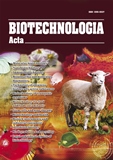ISSN 2410-7751 (Print)
ISSN 2410-776X (Online)

Biotechnologia Acta Т. 16, No. 5 , 2023
P. 55-60, Bibliography 17, Engl.
UDC:: 57.088.2
DOI: https://doi.org/10.15407/biotech16.05.055
Full text: (PDF, in English)
APROBATION OF PLATELET AGGREGATION INHIBITOR FROM ECHIS MULTISQUAMATIS SNAKE VENOM IN VITRO, IN VIVO AND EX VIVO
Zhelavskyi M.A.1, 2, Platonov M.O.1, Kucheryavyi Y.Р.1, Stohnii Y.M. 1
1. Palladin Institute of biochemistry of National Academy of Sciences of Ukraine, Kyiv
2. ZL “Success Academy”, Kyiv region, Ukraine
Snake venom-derived platelet aggregation inhibitors can be promising antiplatelet medications that can allow to avoid the risk of bleeding and treatment resistance, particularly in aspirin-resistant patients. Our study aimed to assess the effectiveness of a platelet aggregation inhibitor derived from Echis multisquamatis snake venom in various settings, including in vitro, in vivo, and ex vivo.
Methods. We examined a polypeptide from Echis multisquamatis venom, purified using a recently developed chromatography protocol, across multiple models. This polypeptide was introduced into platelet-rich blood plasma and administered intravenously to rats. The effects on platelet aggregation were assessed using aggregometry, focusing on ADP-induced aggregation.
Results & Discussion. Our findings revealed that a concentration of 0.040 mg/ml significantly reduced platelet aggregation in vitro. Remarkably, this dosage also proved effective when administered intravenously in laboratory animals, reaffirming its potential as a robust antiplatelet agent. In the final phase of our study, the polypeptide demonstrated its ability to inhibit platelet aggregation in the blood plasma of pregnant women with aspirin resistance, presenting a promising avenue for innovative treatment approaches in such cases.
Conclusion. This study underscores the potential of the Echis multisquamatis venom-derived polypeptide as a promising antiplatelet agent, effective in diverse scenarios, including aspirin resistance. Further research and clinical trials are imperative to harness its therapeutic potential fully..
Key words: disintegrin, blood plasma, platelets, thrombosis, blood coagulation, platelet aggregation, animal model.
© Palladin Institute of Biochemistry of National Academy of Sciences of Ukraine, 2023
References
1. Mărginean, A., Bănescu, C., Scridon, A., & Dobreanu, M. Anti-platelet Therapy Resistance - Concept, Mechanisms and Platelet Function Tests in Intensive Care Facilities. Journal of critical care medicine (Universitatea de Medicina si Farmacie din Targu-Mures). 2016, 2(1), 6–15. https://doi.org/10.1515/jccm-2015-0021
2. Kumar, A., & Kao, J. Platelet resistance to antiplatelet drugs. Recent patents on cardiovascular drug discovery. 2009, 4(2), 98–108. https://doi.org/10.2174/157489009788452959
3. Ferraris, V. A., Ferraris, S. P., & Saha, S. P. Antiplatelet drugs: mechanisms and risks of bleeding following cardiac operations. The International journal of angiology : official publication of the International College of Angiology. Inc. 2011, 20(1), 1–18. https://doi.org/10.1055/s-0031-1272544
4. Feher, G., Feher, A., Pusch, G., Lupkovics, G., Szapary, L., & Papp, E. The genetics of antiplatelet drug resistance. Clinical genetics. 2009, 75(1), 1–18. https://doi.org/10.1111/j.1399-0004.2008.01105.x
5. Trenk, D., & Hochholzer, W. Genetics of platelet inhibitor treatment. British journal of clinical pharmacology. 2014, 77(4), 642–653. https://doi.org/10.1111/bcp.12230
6. Echeverría, S. M., Van de Velde, A. C., Luque, D. E., Cardozo, C. M., Kraemer, S., Gauna Pereira, M. D. C., & Gay, C. C. Platelet aggregation inhibitors from Bothrops alternatus snake venom. Toxicon : official journal of the International Society on Toxinology, 2023, 223, 107014. https://doi.org/10.1016/j.toxicon.2022.107014
7. Chérifi, F., & Laraba-Djebari, F. Bioactive Molecules Derived from Snake Venoms with Therapeutic Potential for the Treatment of Thrombo-Cardiovascular Disorders Associated with COVID-19. The protein journal. 2021, 40(6), 799–841. https://doi.org/10.1007/s10930-021-10019-4
8. Kuo, Y. J., Chung, C. H., & Huang, T. F. From Discovery of Snake Venom Disintegrins to A Safer Therapeutic Antithrombotic Agent. Toxins. 2019, 11(7), 372. https://doi.org/10.3390/toxins11070372
9. Lazarovici, P., Marcinkiewicz, C., & Lelkes, P. I. From Snake Venom's Disintegrins and C-Type Lectins to Anti-Platelet Drugs. Toxins. 2019, 11(5), 303. https://doi.org/10.3390/toxins11050303
10. Frangieh, J., Rima, M., Fajloun, Z., Henrion, D., Sabatier, J. M., Legros, C., & Mattei, C. Snake Venom Components: Tools and Cures to Target Cardiovascular Diseases. Molecules (Basel, Switzerland. 2021, 26(8), 2223. https://doi.org/10.3390/molecules26082223
11. Van den Kerkhof, D. L., van der Meijden, P. E. J., Hackeng, T. M., & Dijkgraaf, I. Exogenous Integrin αIIbβ3 Inhibitors Revisited: Past, Present and Future Applications. International journal of molecular sciences. 2021, 22(7), 3366. https://doi.org/10.3390/ijms22073366
12. Khan, H., Kanny, O., Syed, M. H., & Qadura, M. Aspirin Resistance in Vascular Disease: A Review Highlighting the Critical Need for Improved Point-of-Care Testing and Personalized Therapy. International journal of molecular sciences. 2022, 23(19), 11317. https://doi.org/10.3390/ijms231911317
13. Lordkipanidzé, M., Pharand, C., Schampaert, E., Turgeon, J., Palisaitis, D. A., & Diodati, J. G. A comparison of six major platelet function tests to determine the prevalence of aspirin resistance in patients with stable coronary artery disease. European heart journal. 2007, 28(14), 1702–1708. https://doi.org/10.1093/eurheartj/ehm226
14. Chernyshenko, V., Petruk, N., Korolova, D., Kasatkina, L., Gornytska, O., Platonova, T., Chernyshenko, T., Rebriev, A., Dzhus, O., Garmanchuk, L., & Lugovskoy, E. Antiplatelet and anti-proliferative action of disintegrin from Echis multisquamatis snake venom. Croatian medical journal. 2017, 58(2), 118–127. https://doi.org/10.3325/cmj.2017.58.118
15. Chernyshenko V., Shteinberg K., Lugovska N., Ryzhykova M., Platonova T., Korolova D., Lugovskoy E. Preparation of highly-concentrated autologous platelet-rich plasma for biomedical use. The Ukrainian Biochemical Journal. 2019, 91(2), 19–27. https://doi.org/10.15407/ubj91.02.019
16. Korolova D.S., Pavlenko A.O., Altorjay A., Zhuk S.I., Us I.V., Tsaryk Y., Suranyi A., Chernyshenko V.O. Validation of the diagnostics algorithm to monitor coagulation parameters in pregnant women. The Ukrainian Biochemical Journal. 2023, 95( 3), 33–41. https://doi.org/10.15407/ubj95.03.033
17. Górska P. Principles in laboratory animal research for experimental purposes. Medical science monitor : international medical journal of experimental and clinical research. 2000, 6(1), 171–180.

